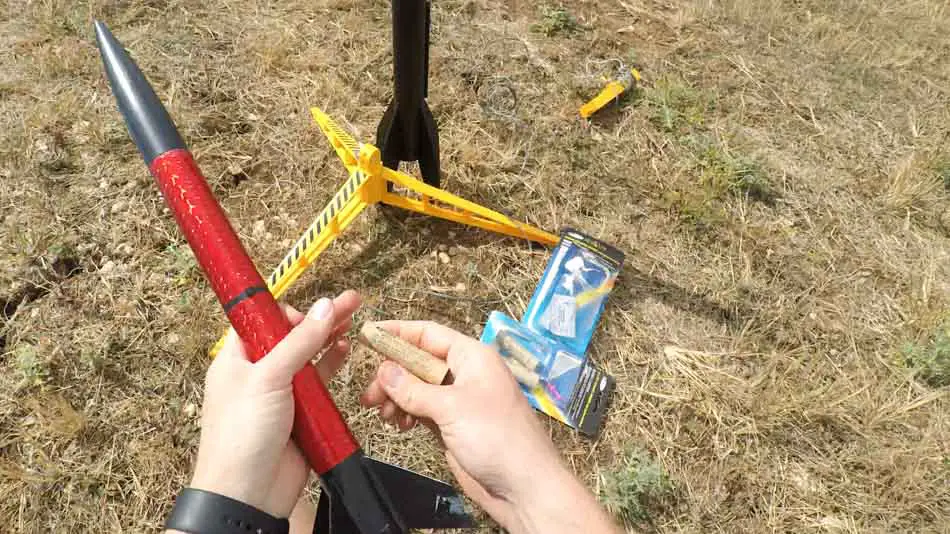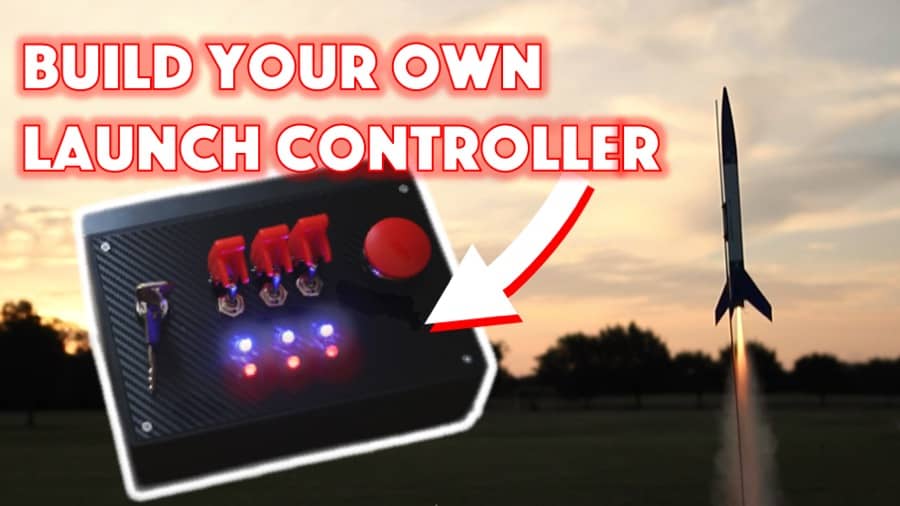
Many people know model rockets are ignited using electricity, but not many people other than those who operate them know how many volts they require to get off the ground.
So how many volts does it take to launch a model rocket? The minimum voltage required to launch an Estes rocket is about six volts (at two amps).
Circuitry in model rocket launches and the voltage involved is an important part of getting rockets off the ground. Read on to find out more about voltage in launching model rockets and how it plays a role in ignition.
Are you still using the standard Estes controllers for your launches?
We just built our own beautiful launch controllers that make launches SO much more fun, and we documented EVERY single step and item purchased and put it into a step-by-step course that teaches you how to do the exact same thing.
Click here to learn more about how you can build your own launch controllers!

How are Model Rockets Powered by Voltage?
The electrical ignition used to spark a model rocket is arguably the most important reaction in the launch chain. Without this electrical trigger, the model rocket could never get off the ground because there would be no spark to ignite the rocket’s fuel or propellant.
Using electricity, the launch controller triggers the igniter to spark, and this spark, in turn, ignites the rocket’s propulsion system and sets it off.
From the smallest model rockets to the large rockets shot off during the Space Race, all rocketry operates on the same basic launch principles, so the launch controller used by an amateur rocketeer is essentially a miniature and simplified version of the same systems used to fire full-scale rockets.
Ways to Provide Power to Launch a Model Rocket
First of all, if you need a refresher on the launch process, see our article on How Do You Ignite a Model Rocket?
There are several ways available to provide power to ignite model rocket. In terms of how much electricity is needed, this Estes guide states that Estes igniters requires 2 amperes at 6 volts to ignite. If you need a refresher on the relationship between amps and volts, that same guide also provides some helpful background.
In order to provide that electricity to ignite the igniter, a launch controller is used that will send the necessary electricity for the launch sequence. There are two options when it comes to launch controllers:
- Prefabricated launch controllers: Many major rocketry companies, such as Estes and Apogee, have prefabricated launch controllers for sale that are essentially a “plug and play” igniter for model rocket launches.
- Handmade launch controllers: Using simple wiring and a nine- or twelve-volt battery, many rocketeers can eventually be capable of constructing their own customized launch controller. While a DIY launch controller can be a little more difficult to put together than a prefabricated one, there is a lot of joy to be had in building your whole system by hand.
Several companies such as Estes sell prefabricated model rocket launchers that are already rigged for launch, and simply need the addition of an appropriately sized battery.
Prefabricated Model Rocket Launchers
If you are concerned that you don’t understand the electrical theory behind building a launch controller, but you still want to launch model rockets, you always have the option of buying a prefabricated model rocket launch controllers. The following launch controllers are available for those that want a less intricate setup.
- Estes PS II Launch Controller (link to read reviews on Amazon): This rocket launcher is suitable for launching cluster engine powered rockets and is essentially a “plug and play” model. All that’s needed is the addition of C batteries, and you are ready for launch.
- Estes Electro Beam Launch Controller (link to read reviews on Amazon): This rocket launcher is a good option for all ages and is run off of four AA batteries, which makes powering it both convenient and safe for children. This controller also includes instructions and a safety key. If you’re at all familiar with model rocketry, you’ve most likely used this controller at some point in your launches.
- Estes 2222 Porta-Rad II Rocket Launch Pad and Electron Beam Launch Controller Combo (link to read reviews on Amazon): This launcher is a good all-in-one package for rocketry since it contains the launch pad and the launch controller rolled into one package.
Prefabricated model rocket launchers are a practical choice for less experienced users, as it does require some basic knowledge in circuits and electricity in order to build a launch controller from scratch.
Homemade Model Rocket Launchers
For more experienced model rocketeers, there is a lot of satisfaction to be hand from construction and wiring a launch controller on your own. We actually set out to build our own launch controllers to increase the satisfaction of the launch experience, and what we found on the internet was a complete lack of guidance on how to do this.
We spent SO much time, money, and frustration buying parts that didn’t work or didn’t work together, but finally came up with an end product that we were SUPER happy with.
In fact, we documented every step of the assembly process and every good piece of material purchased and aggregated it into a step-by-step course that you can use to build your own launch controller! As mentioned above, it’s called License to Launch.
Here’s a sneak peak!
Click here to learn more about how you can build your own launch controllers!
Innovative Ways to Launch a Rocket
Along with traditional launch controllers, some rocketeers have gone even further to introduce new levels of innovation into their launch controller construction. Here is a rocketeer who actually built a launch controller out of a Nintendo 64 controller:
Launch controllers can also be built that integrate Arduino, an open source microcontroller that allows the rocketeer to further modify and customize their launch controller with things like countdown timers and other cool programs.
Is the Voltage Necessary to Launch a Model Rocket Dangerous?
While nine and twelve volts aren’t really enough to electrocute a person, a 9-volt battery can be somewhat dangerous with regards to fire hazard, since the positive and negative posts on a 9-volt battery are quite close together. If anything conductive falls across the two battery terminals of a 9-volt battery, it can create a short circuit and cause a fire.
To avoid starting a fire when using a 9-volt battery to launch model rockets, observe the following safety protocol:
- Do not store 9-volt batteries near any metal objects or objects that can easily conduct electricity.
- Do not remove batteries from the packaging until you are ready to use them and install them in a launch controller.
- Do not dispose of 9-volt batteries with metal or other conductive materials.
- When not in use, keep battery posts covered with electrical tape to prevent accidental contact with conductive objects.
When hand-rigging a launch system for model rockets, it’s important to understand basic concepts regarding electricity and how things like voltage and amperage work before taking on any kind of electrical do-it-yourself project.
Luckily, there are many guides available that make this construction a much safer and simpler process to take on. And with a few minor precautions, anyone can use batteries to launch model rockets with ease and safety.
Conclusion
Launching model rockets on simple electrical circuits is a great way to introduce anyone to both the joys of constructing and shooting model rockets along with an education on some basic technical and scientific principles they can use in other areas as well.
To provide the voltage required for launch, both prefabricated and homemade launch controllers are a great choice to achieve blastoff. No matter which one you ultimately go with, launching a model rocket is an enjoyable experience for the whole family.
